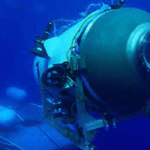As a major search for a submersible that disappeared while transporting five people to the Titanic wreck continued early on Wednesday in a remote area of the North Atlantic, a Canadian military surveillance aircraft heard sounds underwater.
The US Coast Guard did not clarify on what the noises were thought to be, but it did give a glimmer of hope for those still missing onboard the Titan, since estimations predict as little as a day’s worth of oxygen could be available if the vessel is still operational.
Meanwhile, doubts remain over how teams could reach the missing submersible, which could be as deep as 12,500 feet (3,800 meters) below the surface near the famed ocean liner’s underwater tomb. Newly discovered claims also show that major concerns concerning vessel safety were issued throughout its development.

Lost aboard the vessel are pilot Stockton Rush, the CEO of the company leading the expedition. His passengers are a British adventurer, two members of a Pakistani business family and a Titanic expert.
The Coast Guard wrote on Twitter that a Canadian P-3 Orion had “detected underwater noises in the search area.” Searchers then moved an underwater robot to that area to search. However, those searches “have yielded negative results but continue.”
“The data from the P-3 aircraft has been shared with our U.S. Navy experts for further analysis which will be considered in future search plans,” the Coast Guard said.
The Coast Guard statement came after Rolling Stone, citing what it described as internal U.S. Department of Homeland Security emails on the search, said that teams heard “banging sounds in the area every 30 minutes.”
In underwater disasters, a crew unable to communicate with the surface relies on banging on their submersible’s hull to be detected by sonar. However, no official has publicly suggested that’s the case and noises underwater can come from a variety of sources.
Nonetheless, the findings have given some people optimism, notably The Explorers Club’s president, Richard Garriott de Cayeux.
Three C-17 transport planes from the U.S. military have been used to move commercial submersible and support equipment from Buffalo, New York, to St. John’s, Newfoundland, to aid in the search, a spokesperson for U.S. Air Mobility Command said.
The Canadian military said it provided a patrol aircraft and two surface ships, including one that specializes in dive medicine. It also dropped sonar buoys to listen for any sounds from the Titan.
Rescuers have been racing against the clock because even under the best of circumstances the vessel could run out of oxygen by Thursday morning.
In addition to an international array of ships and planes, an underwater robot had started searching in the vicinity of the Titanic and there was a push to get salvage equipment to the scene in case the sub is found.
The carbon-fiber sailboat went missing Sunday night, prompting authorities to launch a search in waters approximately 435 miles (700 kilometers) south of St. John’s.
According to David Concannon, an adviser to OceanGate Expeditions, which handled the project, the submersible had a four-day oxygen supply when it set sail about 6 a.m. Sunday.














